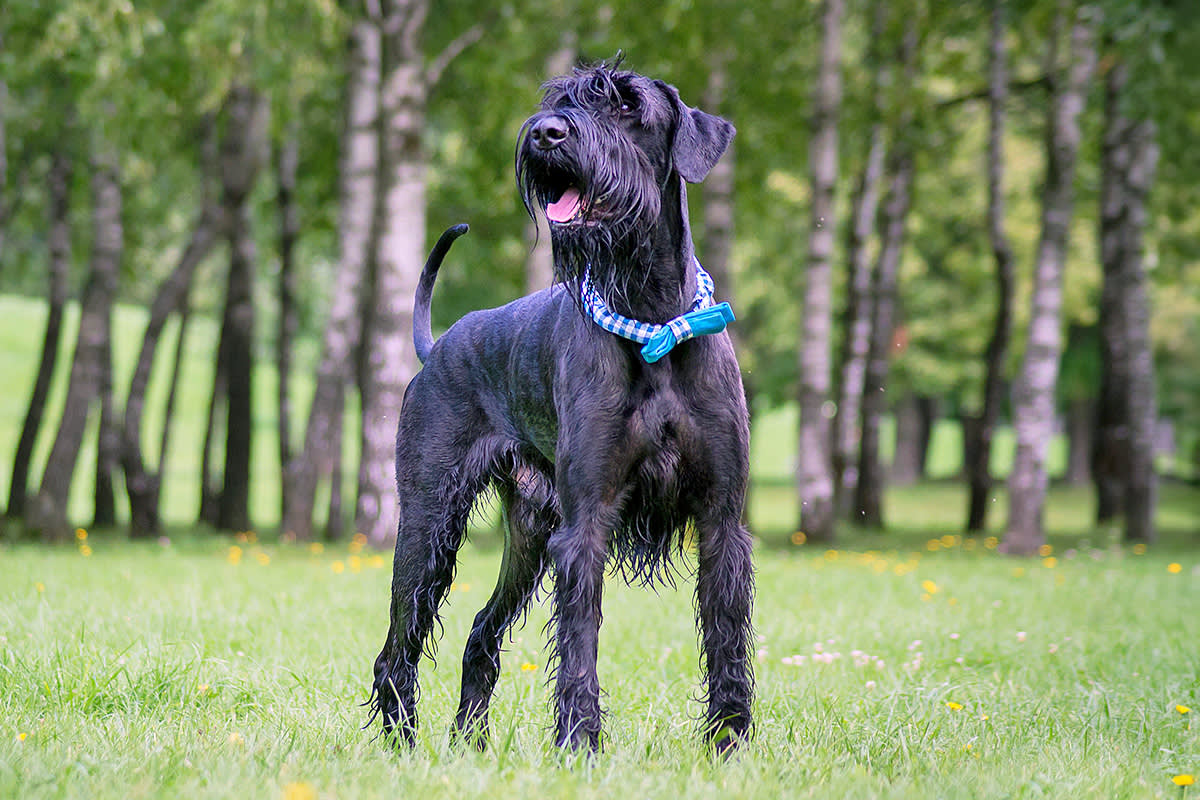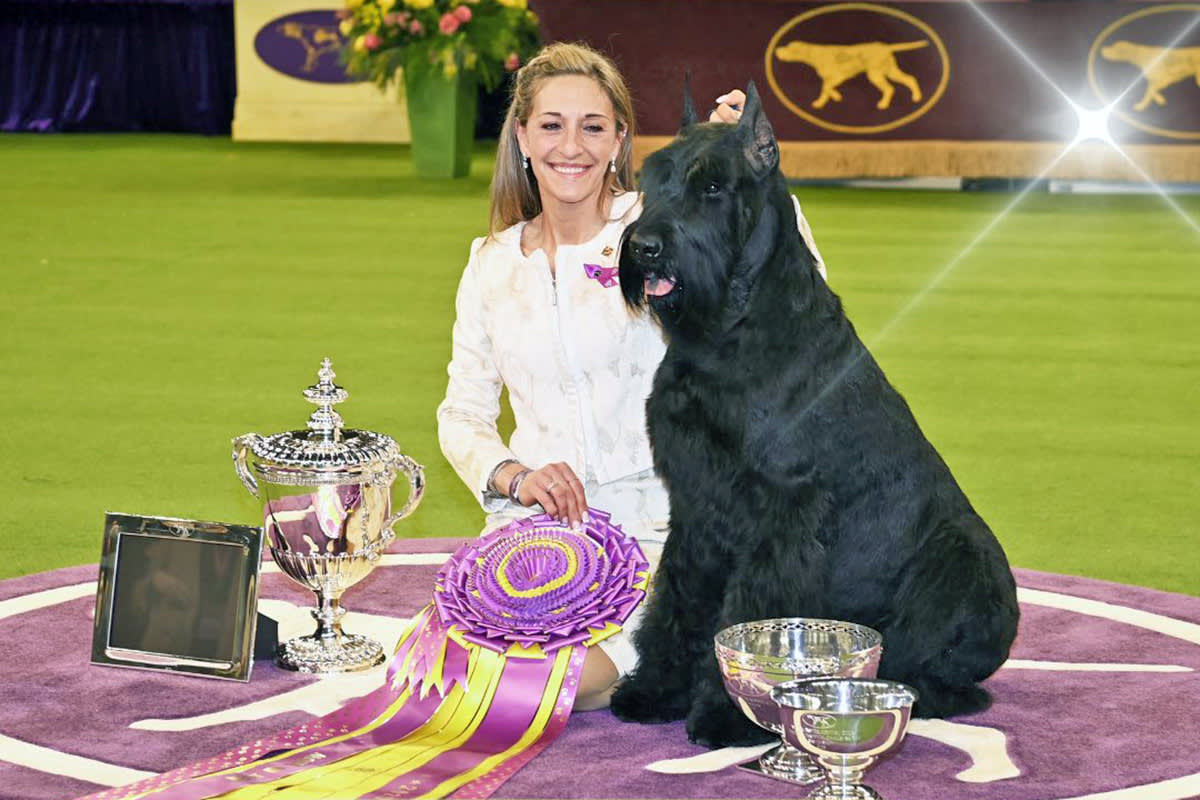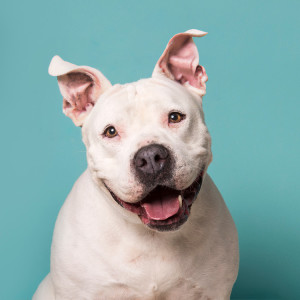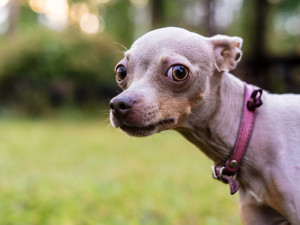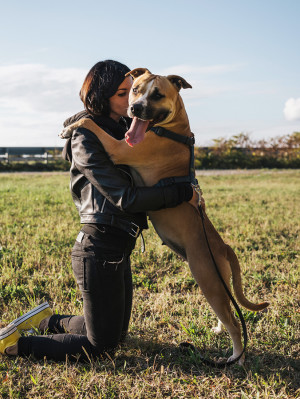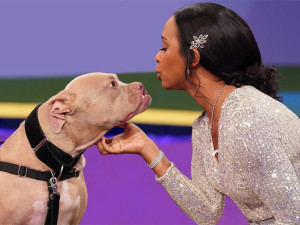The Westminster Best in Show Winner Has Cropped Ears—and People Are Ticked Off
Monty received a history-making honor, but his cosmetic procedure has raised some eyebrows.
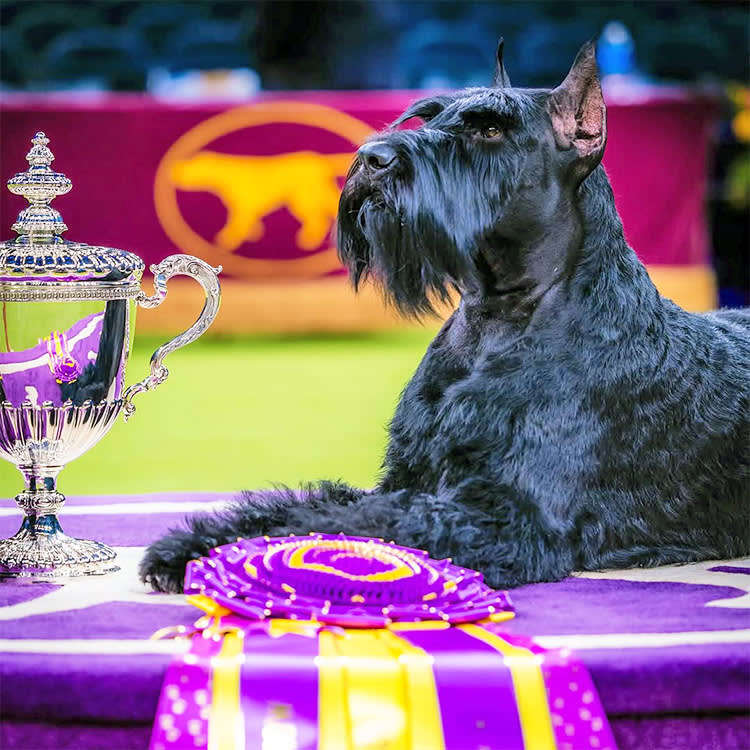
Share Article
Last week, a Giant Schnauzer named Monty opens in new tab made history. He is the first of his breed to win Best in Show at the Westminster Kennel Club Dog Showopens in new tab, an American Kennel Club (AKC)-sanctioned event. He’s a gorgeous dog, and we want to take a moment to congratulate sweet Monty for his achievement, but many online commenters voiced concern over his cropped ears and docked tail.
“Please stop the cropping of ears and tails of all dog breeds!” writes @leatothemoonandback under a pictureopens in new tab of Monty posted on the @westminsterkennelclub Instagram. “Stop mutilating these creatures,” @ashton.roxie says. “Stop cutting ears!! It’s archaic, unnecessary and cruel,” writes @s.p.lind under a photo postedopens in new tab by The New York Times. “Seems strange that a dog that would be banned for docking ears at Crufts wins in USA,” writes @3poodlebrothers. “I couldn’t get over that [… and] I don’t feel this practice should have been rewarded.”
Indeed, Cruftsopens in new tab, one of the largest and most prestigious dog shows in the world, has long banned dogs with cropped ears from competition. Crufts is owned and operated by The Kennel Clubopens in new tab (also known as The Royal Kennel Club) based in the U.K., and their website makes their stance on croppingopens in new tab very clear: “Ear cropping is a barbaric practice,” they say. “The Kennel Club has always been against ear cropping and banned dogs with cropped ears from our events over 100 years ago, so we are deeply concerned that this barbaric practice is becoming more widespread. We continue to work to support efforts to reduce the supply and demand for dogs with cropped ears in the U.K., educate owners about the health and welfare implications for these dogs, and support restrictions on the importing of dogs with cropped ears.”
The World Dog Show also bans dogsopens in new tab with cropped ears or docked tails. Cropping is actually illegal in much of Europe, and though the American Kennel Club (AKC) insists that it is harmless,opens in new tab many vets and animal rights activists disagree. “It’s an amputation,” veterinarian Dr. Randall Cannon opens in new tab tells Kinship. “The dogs are really going through hell. You have to suture the entire edge of the ear until it heals, which takes a couple weeks, but then, [to get the newly cut ears to stand up straight] stents are placed that go into the ears and the ears are then taped to train them to grow straight up.”
Dr. Cannon says stenting can sometimes take three to four months, depending on the length of the dog’s remaining ear tissue. During that time, the ear canals are closed off, which can cause yeast infections. Cropping is surgery and requires dogs to be anesthetized. The procedure is usually done when dogs are between 12 and 14 weeks old.
“Dogs that are younger and smaller than that are too difficult to safely anesthetize,” Dr. Cannon adds. “It’s a simple surgery, but easy to get wrong, because getting the ears to match is really difficult.” Dr Cannon graduated from vet school in 1990. Early in his career, he worked for a veterinarian who regularly performed the procedure, so he is familiar with the realities of cropping, though he has never done it himself. “Seeing what these puppies were going through, I couldn’t do it.”
What to know about tail docking
Dr. Cannon did perform docking procedures at one point, but stopped in the mid-1990s because he found them “repulsive.” Docking is when a dog’s natural tail is cut short, and it is usually done when they are just a few days old. While cropping is done under general anesthesia, Dr. Cannon says docking is often performed with no anesthetic whatsoever.
“At three days of age, a dog could be the size of your palm, so you can’t get a tube down their throat to help them breathe,” Dr. Cannon says. “Instead, you put a hemostat clamp on the end of the tail and just cut it off.” It is possible to use a local anesthetic, like lidocaine, on the tail before clamping, but lidocaine burns and getting it in exactly the right spot to be effective is difficult. He says it’s also cheaper to simply clamp and cut, which helps breeders maintain the highest possible margins when selling the puppies.
Most vets don’t recommend tail docking anymore, but it has a deeply rooted history within the U.S. As the American Veterinary Association (AVMA) statesopens in new tab, “There is a continuing tradition of docking working dogs’ tails with the goal of preventing tail injury during activities such as hunting. Early references, however, tended to suggest docking only in cases where the tail was overly long for the size of the animal and, therefore, might be prone to injury.” They go on to say that pedigree dog shows in the U.S. established docking as a requirement in the 1950s. The AVMA first suggested removing this procedure in 1976, though it remains a requirement in AKC standards.
Tail docking is part of the standard of around 60 dog breeds competing in shows like Westminster. Indeed, the AKC insists on dockingopens in new tab in the cases of breeds like the Giant Schnauzer, which it says “should be docked to the second or not more than the third joint (approximately one and one-half to about three inches long at maturity).” The AKC claims opens in new tab that the procedure does not hurt, but Dr. Cannon says that is not necessarily true and, in either case, it’s completely unnecessary.
The AKC justifies standards relating to docking and cropping by pointing to historical precedents. “The Boxer, for example, is a working dog that has traditionally been used for a number of important tasks including serving as guard and courier dogs for soldiers and seeing-eye dogs for the blind. The cropped ears help enhance the Boxer’s hearing, thereby helping it perform its tasks to the best of its ability,” they writeopens in new tab. “Other dogs, such as the Brussels Griffon, were historically kept in stables to catch vermin or other pests. Cropping the ears protected them from damaging bites when cornering a rat or another unwelcome animal.”
Of course, dogs competing in shows like Westminster are unlikely to work a day in their lives, let alone find themselves in a situation where they are hunting rats in a barn. “Dogs can hear just fine without having their ears cropped,” Dr. Cannon says. “That is just an excuse to justify a choice that is completely aesthetic. And if you’re worried about your dogs’ ears getting ripped off by an animal, maybe don’t go siccing them on wild animals in the first place.”
Although tail docking is required by many AKC standards, ear cropping is optionalopens in new tab. “Ear cropping is a decision made by a dog’s breeder or owner,” the AKC writes on the FAQ page opens in new tab of their website. “While it is true that some breeds are shown with their ears cropped, there is nothing in AKC rules and in fact nothing in any breed standard that compels an owner to have this procedure performed as a prerequisite to entry at a dog show.”
Here is what the AKC says on the Official Standard pageopens in new tab for the Giant Schnauzer: “When cropped, [ears are] identical in shape and length with pointed tips. They are in balance with the head and are not exaggerated in length. They are set high on the skull and carried perpendicularly at the inner edges with as little bell as possible along the other edges. When un-cropped, the ears are V-shaped button ears of medium length and thickness, set high and carried rather high and close to the head.”
Does listing the standards for cropped ears ahead of un-cropped ones mean the AKC has a preference for one over the other? The AKC, Westminster Kennel Club did not respond to emails asking for comment. But Chris Reed, president of the Giant Schnauzer Club of Americaopens in new tab had this to say: “Cropping and docking are legal practices throughout the United States. Accordingly, many breeders and owners view it as a choice they have the right to make.”
Yes, it’s legal, but there’s still this question: If the procedure really does make no difference in the judging process, why did Monty’s breeder, Cherlann Ambrose of Hearthmore Giant Schnauzersopens in new tab, and his parents choose to crop his ears? Ambrose also did not respond to requests for comment.
Dewclaw removal on dogs
The standard for Giant Schnauzers and other dog breeds also includes a section on declawing, which is required in the case of hind legs, but it’s optional on forelegs. Declawing for dogs is not the same as it is for cats, as it only requires the removal of a single digit on each limb. That digit is called a dewclaw and is located higher up on the leg than the rest of the dog’s claws.
On hind legs, it is often just a flap of skin, which is often removed at the same time that tail docking is done, “sort of like removing a skin tag in a human,” Dr. Cannon says. The rear dewclaw serves no purpose and can actually get caught on things and be a site of recurring injury if left in place.
“There’s no bone or nail or anything in most cases,” Dr. Cannon says. Actually, many dogs are born without rear dewclaws of any kind. On the forelegs, however, that dewclaw is functional and can help dogs grip, sort of like a thumb. The decision to remove foreleg dewclaws is purely aesthetic and means the removal of an otherwise functional digit.
The AKC’s defense of these procedures
On their website, the AKC is vehement in their defense of docking, cropping, and declawing, saying that people who say it is cruel and unnecessary don’t know what they are talking about.
They writeopens in new tab: “Much of the opposition regarding these procedures comes from a misunderstanding of why and how they are performed. Many believe that these procedures are painful, performed purely for convenience or cosmetic reasons and have no value. This is completely false.” They go on to say that “these procedures are significantly less painful and much less physically traumatic for the dogs than common surgeries such as spaying and neutering.” They add that “ear cropping and tail docking preserves a dog�’s ability to perform its historic function.”
But, of course, we don’t neuter or spay dogs for aesthetic reasons. We do it to control the pet population, among other medically recommended reasons. Neutering and spaying have certain health and behavioral benefitsopens in new tab that docking, cropping, and declawing the foreleg dewclaw do not.
The bottom-line truth about ear and tail docking
Unless a dog has cancer or becomes injured and needs to have part of their ear or tail removed, there is no reason to do so beyond the aesthetic preferences of the dog’s pet parents or breeder. The AKC says that these aesthetic interventions are part of preserving a dog’s ability to perform their historic function. If that is actually important, why not add a practical component to the judging at these showsopens in new tab?
The standards that are used to judge dogs at competitions like the Westminster Dog Show are purely aesthetic, no matter what fans of docking and cropping might say to the contrary. They are also, ultimately, arbitrary. And as long as the AKC and other organizations continue to support the practice of cutting parts off dogs that people find aesthetically inferior, it will continue to happen.
References
American Kennel Club. “Official Standard of the Giant Schnauzer.” https://images.akc.org/pdf/breeds/standards/GiantSchnauzer.pdf.opens in new tab Accessed 17 Feb. 2025.
AVMA. “Canine Tail Docking FAQ.” American Veterinary Medical Association, 2024, www.avma.org/resources-tools/animal-health-and-welfare/animal-welfare/canine-tail-docking-faq.
“Ear Cropping | Campaigns | the Kennel Club.” Www.thekennelclub.org.uk, www.thekennelclub.org.uk/about-us/campaigns/ear-croppingopens in new tab. Accessed 17 Feb. 2025.
“Issue Analysis: Dispelling the Myths of Cropped Ears, Docked Tails, Dewclaws, and Debarking.” American Kennel Club, 22 May 2013, www.akc.org/expert-advice/news/issue-analysis-dispelling-myths/?rel=sponsoreopens in new tabd. Accessed 17 Feb. 2025.
“Regulations – World Dog Show.” Worlddogshow.ch, 2023, www.worlddogshow.ch/en/en-regulations/opens in new tab. Accessed 17 Feb. 2025.
Peltz, Jennifer. “Giant Schnauzer Named Monty Wins Westminster’s Best in Show.” AP News, 11 Feb. 2025, apnews.com/article/westminster-kennel-club-best-show-ec5dd7767afc63f1a658f2ec3040503aopens in new tab. Accessed 17 Feb. 2025.

Charles Manning
Charles Manning is an actor and writer based in New York City. In his free time he likes to cook, go swimming at the public pool, volunteer at the LGBTQ senior center, and foster senior and special-needs cats. His work has previously appeared in Cosmopolitan, Elle, Marie Claire, Harper’s Bazaar, Seventeen, and Nylon.
Related articles
![a dog photographed by Sophie Gamand]()
Why I Used AI to Reconstruct Cropped Dog Ears
Vets everywhere agree that ear cropping is an unnecessary procedure that can lead to health problems. See how I gave these pups their ears back.
![Russian Toy Terrier with ears back]()
9 Reasons Why Dogs Put Their Ears Back
Here’s how your dog’s ears can clue you in to how they’re feeling.
![A woman embraces her American Staffordshire terrier dog outdoor in the backyard.]()
7 Myths Harmful to Pit Bulls—Debunked
These sweet pups need advocates, this National Pit Bull Awareness Month, and always.
![National Rescue Dog Show]()
4 Dog Shows That Give Mixed Breeds a Chance to Shine
We’re excited for the Westminster Dog Show, but we also want to highlight dog competitions that lift up non-purebred dogs.
![Two boxer dogs playing with a ball together in the park]()
Docked Tails Play a Role in Dog Communication
Looks aren’t everything, but they can talk.
